
By Bill Gustin
Firefighters responded to a fire in an old stucco and wood-frame house. On arrival, they found smoke pushing from window frames and roof soffit vents on the B side (side 2) of the house. On entering, they found no contents burning; the only sign of fire was smoke pushing from the baseboard and from around window frames on the B-side wall.
Faulty Electrical Wiring Suspected
Since there was no external source of ignition, firefighters were confident that the fire must have been started by faulty electric wiring inside the wall, which is not unusual for older homes in this neighborhood. Firefighters cut the power at the circuit breaker panel and, with a charged hoseline ready, opened the wall. To their dismay, there was no electrical wiring anywhere near the area of the most intense burning, which, in their experience, was the point of origin. “There has to be wiring in this wall!” said the ladder company captain, who was determined to find it. The captain suspected that faulty wiring started the fire by energizing the wire lath for the wall’s exterior stucco. He had seen it before: The lath heats the wood studs it is nailed to and, over time, brings them to the point of ignition.
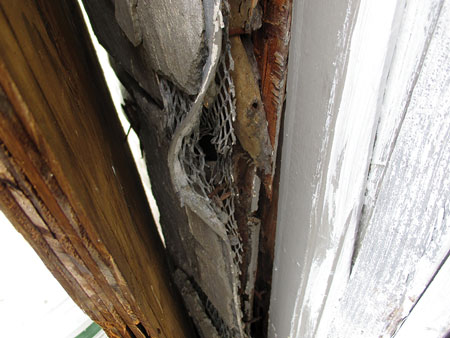 |
| (1) Wire lath energized by faulty wiring eventually ignited the wood as the result of pyrophoric carbonization. (Photos by Eric Goodman unless otherwise noted.) |
Determined to find the wiring that started this fire, he ordered his firefighters to open stud bays on each side of the point of origin until they found it. The captain was frustrated; his firefighters stripped wood lath and plaster from the wall, exposing several stud bays, and still couldn’t find any wiring. Firefighters noticed another abnormality: The studs on each side of the point of origin were almost burned completely through, which is inconsistent with a relatively small fire that was reported as soon as the homeowner smelled smoke. The captain requested a fire investigator. He wondered how it was possible to have deeply charred wood inside a wall and no wire in sight.
Fire Investigator Report
The primary reason fire departments must determine the cause of a fire is to eliminate it so it does not start another fire. Since the baffled and frustrated ladder company captain could not determine the cause of this fire, he requested the assistance of a fire investigator. After examining and photographing the fire damage, the investigator, who had several years of experience, asked the homeowner if he had had any problems with the home’s electricity, such as lights flickering or dimming. He also asked if anyone had ever felt a shock when touching an electrical appliance or water pipe. The owner said that his lights occasionally dimmed when the central air conditioner’s compressor turned on and that, recently, he was shocked when he touched the sink when he was barefoot and the kitchen floor was wet.
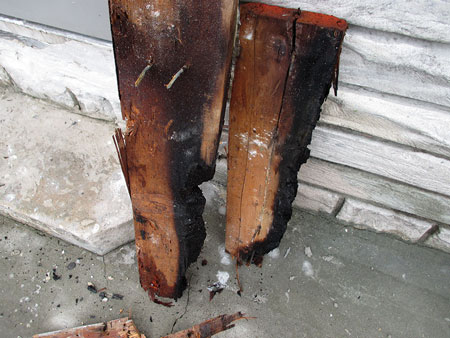 |
| (2) Wire lath energized by faulty wiring eventually ignited the wood as the result of pyrophoric carbonization. (Photos by Eric Goodman unless otherwise noted.) |
The investigator then asked the homeowner if any construction, electrical, or plumbing work was done recently. The homeowner replied that he had a plumbing problem that was repaired more than a year ago. On further questioning, the investigator learned that plumbers had replaced a section of an old galvanized steel pipe connected to the water service with PVC plastic pipe. This information was critical because the wiring in most of the old homes in this neighborhood are grounded to the water pipes; most do not have grounding wires connected to stakes driven in the ground, a requirement of modern electrical codes. Replacing the steel pipes with plastic could interrupt the building’s continuity to ground.
Utility Company Report
The utility company was called. The company’s voltmeter confirmed the investigator’s suspicion: When the power was restored, wire lath nailed to the studs that were burned was energized to 12 volts. Current flowing through the lath was sufficient to cause the wire mesh lath to act like a heating element. The result was a slow, gradual process of drying and heating the wood. Over time, this low-grade heating source caused a thermal decomposition of the cellulose in the wood to a point that it would undergo pyrophoric carbonization. This process would gradually lower the ignition temperature of the wood and eventually ignite the studs. The depth of charring of the studs, which appeared to firefighters as being inconsistent with such a small fire, was, in the investigator’s view, entirely consistent with pyrophoric carbonization (photos 1-2). That still raises the question: How did electricity get into the lath? There were no wires anywhere near the point of origin.
 |
| (3) These attempts to “upgrade” the 1950s-vintage wiring clearly were not performed by a certified electrician or in compliance with the electrical codes. |
Final Determination
The investigator and the power company representative agreed that the fire was probably a result of a combination of problems with the building’s electrical wiring. First, the power company had to rule out that the power company’s neutral leg of the electric service wasn’t “open.” If the power company’s neutral was open, current could not return normally to its source, the transformer, and would tend to “search” for another path. Also, this building still had most of its original wiring, consisting mainly of “BX,” a flexible, metal-clad cable. Like metal conduit, BX achieves its path to ground through its metal covering. A loose connection or a separation anywhere along its spiral metal sheath can break the continuity. If the BX happened to be in contact with anything metallic – say the plumbing or metal lath – either could become the new path to ground. To prevent another fire, the utility company pulled the electric meter and advised the homeowner that power would not be restored until the defect was located and the home’s wiring was repaired in compliance with the electrical code.
Some Basics Related to Electrical Fires and Hazards
I do not pretend to be an electrician and have only a very basic knowledge of electricity. I am, however, a lifelong student of the fire service and, over my career, have reached out to power company workers, firefighters who are electricians, county electrical inspectors, and experienced electrical contractors who have helped me to understand my experiences with electricity.
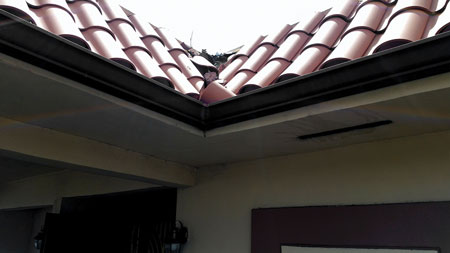 |
| (5) The energized sheet metal flashing ignited wood in the mansard overhanging the front of a funeral home. |
Early in my career, I responded to several fires in concealed spaces with no wiring anywhere near the point of origin, similar to the scenario at the beginning of this article. But, at the time, I did not understand how they occur until I learned from veteran professional electricians. They tell me that electrical fires and hazards are common in my company’s district, where I have worked for 39 years, because so many of the structures are old. There are social, economic, and cultural factors to consider.
Related Factors
Economics are a significant factor because a large segment of the population of my district cannot afford to upgrade the old, outdated wiring in their homes. As a consequence, some homeowners take dangerous measures to update their 1950s vintage wiring to meet the electrical demands of a 21st century household (photo 3). For example, my company sees a lot of fires started by the use of cheap extension cords and power strips used to supply current to all of the things that consume electricity that were not even invented when these homes were wired 50 or 60 years ago.
Cultural factors cannot be ignored either. There are trailer parks in my district that were once home to retired couples who relocated from the Northeast after World War II. The mobile homes, manufactured in the 1940s and 1950s, are now home to immigrants from Central America, who build additions on their trailers to house their large families. It is common for the new residents to extend wiring from the original trailer to poorly constructed additions using methods that worked in their native countries.
Similarly, we see electrical work in residences that clearly was not done by a licensed electrician or in compliance with the electrical code. It seems that just about every homeowner who calls the fire department for an electrical fire or hazard has a relative who is an electrician. For example, say an owner or a tenant of an older home keeps tripping circuit breakers; it would not be uncommon to have a handyman “upgrade” the electrical service by replacing 15-amp circuit breakers with 20-amp breakers. This solves the problem of tripping circuit breakers as far as the resident is concerned, but the resident doesn’t realize that he and his family are at risk. Further, it is doubtful that the handyman who installed the circuit breaker understands that resistance in overloaded circuits can cause wiring to overheat and eventually start a fire. Additionally, he probably has no clue that overheated wiring can start a fire at a current flow well below that necessary to trip the 20-amp circuit breaker.
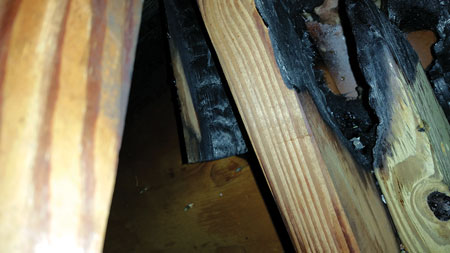
Common Causes of Electrical Fires and Shock
The experienced electricians taught me that many electrical fires and shock hazards are caused by a combination of problems with a building’s wiring and, occasionally, with the power company’s equipment. As an example, for electric current to complete a circuit, it must return to its source. The source of electric power for private dwellings is a transformer, typically on a nearby utility pole or, in the case of underground wiring, on a concrete mat. A household electrical service is supplied by a transformer through two 110-volt wires. These two “hot” wires are insulated and wrapped around a noninsulated “neutral” cable that completes the circuit by returning current from the house back to the transformer.
Occasionally, the power company’s electric service can develop an “open neutral,” usually the result of a defective cable connection where the electric service enters the weatherhead (the connection where the power company’s service wires enter a building). Damage to the power company’s neutral cable can result in an “open neutral,” which can interfere with current returning to the transformer and force it to “search” for another path. Similarly, damaged or improperly installed neutral wiring anywhere in a home’s electrical system can force current to find another path to complete its circuit. Current searching for a path to complete its circuit can arc to metal pipes and building components, which can, over time, result in a fire.
 |
| (8) Arcing was sufficient to burn a hole in the mansard’s sheathing, exposing the underside of the clay barrel tile. |
Gas and electric piping, ventilation ductwork, metal structural members, and improperly grounded television cable can all become energized with current seeking the path back to its source (photo 4). In part 2 of this article, we will examine how metal fences can become energized and shock firefighters. Current can energize the aluminum siding of mobile homes, starting fires and shocking firefighters. Additionally, it is not uncommon for stray current to arc between metal wind straps and the chassis of an old mobile home, igniting its particleboard floor. Wires with worn or damaged insulation can “leak” current that can be insufficient to trip a circuit breaker but enough to cause shocks and fires. Wiring can develop worn spots in its insulation, particularly where it is crammed into tight places, is jammed around sharp corners, and penetrates floors. A nail or screw that inadvertently penetrates wiring inside of a wall can energize any metallic object it touches.
Grounding and bonding are intended to provide a lower resistance path to ground resulting from a lightning strike, damaged wiring, or faulty equipment. Bonding and grounding are safety requirements of electrical codes intended to reduce the chances of a person becoming part of the circuit, but they cannot entirely prevent errant current that is searching for its source from starting an electrical fire. Improper grounding is another problem that alone or in combination with other factors can cause electrical fires and shocks.
Real Fire Scenarios
Scenario 1. Fire companies in my district responded to a reported fire in a funeral home. The first-arriving company found smoke pushing from vents in the underside of the mansard on the front wall of the building. The mansard, covered with clay barrel tile, is an extension of the cockloft that cantilevers over the front wall (photo 5). On entering, firefighters found a very light haze of smoke in the funeral home. The only sign of fire was a glow in gaps around the ceiling light fixtures. Firefighters cut power at the electrical panel, advanced a hoseline into the building, pulled the ceiling, and extinguished the fire in the cockloft and mansard. As in the opening scenario, firefighters, expecting the cause of the fire to be electrical, were surprised to find no electrical wiring anywhere near the point of origin and requested a fire investigator.
The cause of this fire was determined to be an energized mast head pipe between the building’s electrical service weatherhead and its electrical panels. Sheet metal flashing in contact with the mast head pipe was energized around the entire perimeter of the roof. In photos 6 and 7, roof trusses were heavily charred where they cantilevered over the front wall. Additionally, in photo 8, a hole burned through the roof sheathing, exposing the underside of the roof tile.

In photos 9 and 10, it appeared to the investigator that arcing caused a narrowing of the roofing nails that fastened the flashing to the mansard.
In photo 11, a piece of wood from one of the roof trusses had been “cooked” and reduced to charcoal, a classic indication of pyrophoric carbonization. It is not known why current in the flashing traveled such a considerable distance – from the energized mast head at the rear of the building to the trusses in the front mansard. True, the trusses’ metal gusset plates would attract electrical current, but there was no metallic continuous path to ground anywhere near the point of origin. One explanation, that is purely supposition, is that South Florida’s subtropical rains and year-round high humidity give wood a high moisture content, which could give it some measure of conductivity.
Scenario 2. In a similar scenario, my company responded to a fire in the roof of a duplex. On arrival, we found smoke pushing from the attic vents in the plaster soffit overhanging one of the unit’s doorways. A scan of the exterior of the soffit and the attic with a thermal imaging camera (TIC) indicated that the fire was confined to the soffit over the front door. After the power was turned off at the breakers, we opened the soffit and extinguished a small fire. Again, we found wire lath and unusually deep charring of the roof rafter tails, plywood sheathing, and fascia (photos 12-13).
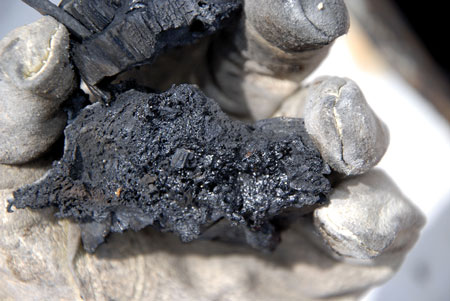 |
| (11) The process of pyrophoric carbonization “cooked” the wood from the truss, reducing it to charcoal. |
We asked the tenants of each duplex unit and the building owner if they had experienced any electrical problems or had any construction, plumbing, or electrical work performed lately. Each person adamantly denied having any knowledge of any work being done on the building. When the fire investigator arrived, he asked two police officers to question the building owner, who readily admitted that he recently installed four security flood lights to the underside of the soffit on the side of his building. When the breakers were turned back on, the new light fixture and the wire lath were found to be energized. A lesson to be reinforced here is that, unfortunately, fire officers cannot believe a civilian’s information about the cause of a fire without verifying it.
Energized Plumbing
Now that we know that current seeking a path back to its source can energize plumbing, let’s examine a result in the following scenario. An engine was dispatched on a single-company response for a report of smoke in the area. The company found smoke pushing from around the window frames and attic soffit vents of a small, stucco-on-wood frame house with plywood covering its windows. The engine’s officer called for a full residential fire response, ordered his company to stretch a hoseline, and began to walk around the structure.
The status of utilities was an important aspect of this officer’s 360° size-up. The officer looked for gas meters, liquid petroleum (LP) gas cylinders, and electric service wires to the fire building. The location and condition of the electric service were important to observe because the service wires could fall if exposed to fire and become a hazard to firefighters, especially if they fell on a metal fence. As he reached the rear, C side, he noticed that the electric meter had been pulled and was replaced with a plastic cover by the utility company. He used his hand light to check for electric service wires; he didn’t find them and assumed correctly that the power company had disconnected and removed them. In some areas, plywood on the windows and no electrical service are strong indications that a house is vacant – but not in this neighborhood. This officer knew that squatters often took up residence in vacant and abandoned structures and got their electricity from an extension cord connected to a nearby house.
On gaining entry, firefighters found several mattresses on the floor; none were on fire. The only indications of fire were on the side-D wall: Smoke was pushing from around a window frame and hot surfaces. With a hoseline in position, the wall was opened and molding was pulled from around the window. The fire was small and was extinguished in seconds with a few gallons of water. As firefighters expanded the opening in the wall to check for extension, they found that the studs on each side of the window and the double 2- × 4-inch header bridging the opening around the window frame were almost completely burned through.
As in previous scenarios, the extent of the fire damage and depth of char weren’t consistent with the amount of fire encountered. Unlike in previous scenarios, however, the engine company officer recognized the signs of an electrical fire but was perplexed because there was no electric service to the house. The mystery became more intriguing when a firefighter using a metal roof hook to open the wall received a strong electrical shock and noticed sparks where his metal tool made contact with wire lath for the exterior stucco. The engine company officer was embarrassed and furious with himself: He must have overlooked an extension cord when he conducted his 360°.
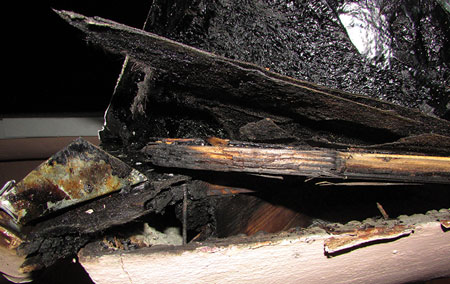
The officer requested an investigator and the power company and then searched in vain for the illusive extension cord. When the power company arrived, the lineman used a volt meter to confirm that the wire lath was electrically energized (photo 14). The experienced and conscientious lineman then took readings of the water pipes under the bathroom sink and found that they, too, were energized. The lineman had experienced this condition before.
His next move was to take voltmeter readings of the fire building’s water meter and the water service of nearby homes. He found that they all, to some degree, were conducting current. This convinced the lineman that an open neutral somewhere in the power company’s system prevented current from one or more homes in the area from returning normally to the transformer. Instead, it followed metal water pipes to ground, energized the water main, and “backfed” current through the fire building’s water service. This incident also showed why water company meter readers sometimes wear rubber gloves – to avoid being shocked – and that cable company installers and gas company employees have been shocked by electricity feeding through their lines.
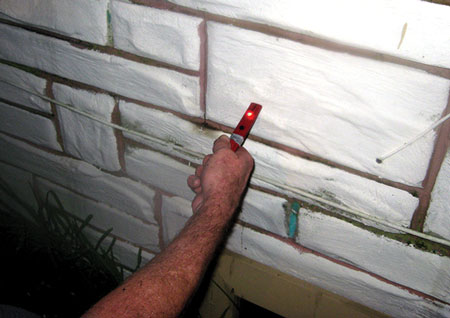 |
| (14) The voltage detector indicated that the wire lath behind the stucco was energized, evidently through the plumbing from the house next door. (Photo by Corey Logan.) |
Part 2 will examine how theft of electricity, down power lines, and metal fences can cause electricity to take a dangerous and unexpected path.
BILL GUSTIN is a 44-year veteran of the fire service and a captain with the Miami-Dade (FL) Fire/Rescue Department. He began his fire service career in the Chicago area and is a lead instructor in his department’s Officer Development Program. He teaches tactics and company officer training programs throughout North America. He is an advisory board member of Fire Engineering and FDIC International.
Electricity in the Air
Electrical Oddities
Electrical Hazards: Is Your Department Prepared?
UNDERSTANDING ELECTRICITY AND ELECTRICAL DANGERS
More Fire Engineering Issue Articles
Fire Engineering Archives

